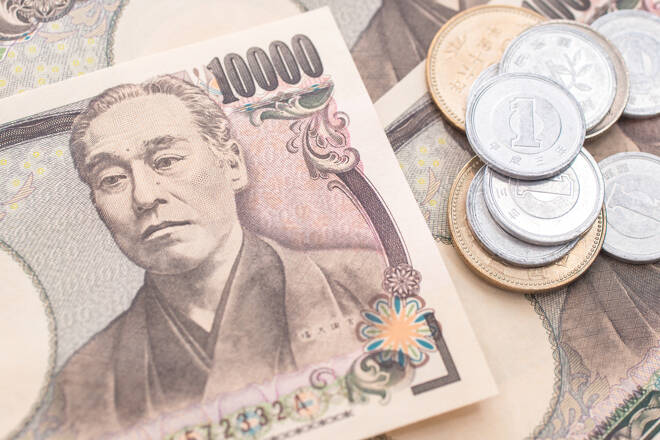Advertisement
Advertisement
USD/JPY Forecast: Bank of Japan’s Impact and US Jobs Report Analysis
By:
Wage growth numbers from Japan could spark hope as softer inflation and weaker GDP may test the Bank of Japan's resolve to exit negative rates.
Highlights
- The USD/JPY tumbled by 2.18% on Thursday, ending the session at 144.092.
- Bank of Japan Governor Kazuo Ueda sank the USD/JPY during a speech on monetary policy.
- On Friday, the Japanese economy was in focus before the all-important US Jobs Report.
USD/JPY Movements on Thursday
The USD/JPY tumbled by 2.18% on Thursday. After a 0.11% gain on Wednesday, the USD/JPY ended the day at 144.092. The USD/JPY rose to a high of 147.310 before crashing to a low of 141.601.
Japanese Economy in the Spotlight
On Friday, household spending, wage growth, and finalized GDP numbers for Q3 were in focus. The numbers could impact bets on a Bank of Japan pivot from negative rates. Bank of Japan Governor Kazuo Ueda sent the USD/JPY crashing after floating possible interest rate moves to parliament.
A pickup in wage growth was the highlight of the numbers. Average cash earnings increased 1.5% year-over-year in October vs. 0.6% in September. The pickup could fuel consumer spending and demand-driven inflation, the missing piece of the jigsaw for the BoJ.
However, household spending declined by 0.1% in October after rising by 0.3% in September. A downward revision to private consumption in Q3 affected the GDP numbers. The Japanese economy contracted by 0.7% vs. a second estimate contraction of 0.5%.
Softer inflation numbers from Tokyo and weaker household spending and GDP numbers could delay a BoJ pivot from an ultra-loose policy. However, the better-than-expected wage growth numbers could support a more upbeat final quarter.
The USD/JPY responded to the numbers, dipping to a low of 143.933 before rising to a high of 144.319.
US Jobs Report and Michigan Consumer Sentiment in Focus
On Friday, the US Jobs Report and consumer sentiment will need consideration. Weaker wage growth and a higher unemployment rate could cement bets on a Q1 2024 Fed rate cut.
Weaker wage growth and a deteriorating economy would reduce disposable income and impact consumer sentiment. The net effect would be a pullback in consumer spending, easing demand-driven inflationary pressures. A softer inflation outlook would allow the Fed to take a less hawkish rate path.
However, consumer confidence also influences consumption. An improving consumer confidence backdrop could signal an upward trend in consumer spending. A pickup in consumer spending would fuel demand-driven inflation and ease bets in a Q1 2024 Fed rate cut.
On balance, the US Jobs Report will likely have a more lasting effect on the US dollar.
Economists forecast the unemployment rate to remain unchanged at 3.9%. Significantly, economists expect average hourly earnings to increase by 0.3% in November vs. 0.2% in October.
Short-term Forecast
Near-term trends for the USD/JPY will hinge on Bank of Japan commentary and the US Jobs Report. A hawkish response to the wage growth figures from Japan and a weaker-than-expected US Jobs Report could send the USD/JPY toward 140.
USD/JPY Price Action
Daily Chart
The USD/JPY remained below the 50-day EMA while holding above the 200-day, affirming bearish near-term but bullish longer-term price signals.
A USD/JPY break above the 144.713 resistance level would bring the 146.649 resistance level into play.
Bank of Japan commentary and the US Jobs Report are likely focal points.
However, a break below the 200-day EMA would give the bears a run at the 142.177 support level.
The 14-day RSI at 29.12 shows the USD/JPY in oversold territory. Buying pressure could intensify at the 200-day EMA.
4-Hourly Chart
The USD/JPY remained below the 50-day and 200-day EMAs, affirming bearish near-term price signals.
A USD/JPY move through the 144.713 resistance level would bring the 146.649 resistance level into play.
However, a drop below the 143 handle could lead to a fall to the 142.177 support level.
The 14-period 4-hour RSI at 29.39 shows the USD/JPY in oversold territory. Buying pressure may intensify at the morning low of 143.806.
About the Author
Bob Masonauthor
With over 28 years of experience in the financial industry, Bob has worked with various global rating agencies and multinational banks. Currently he is covering currencies, commodities, alternative asset classes and global equities, focusing mostly on European and Asian markets.
Advertisement
